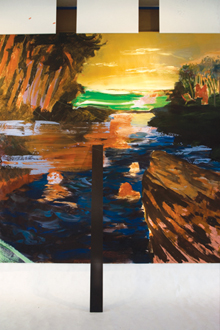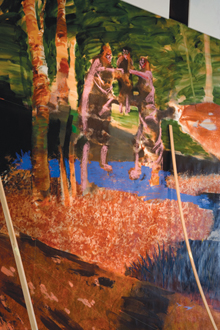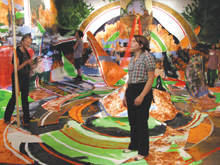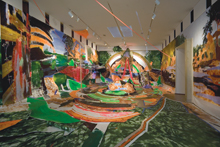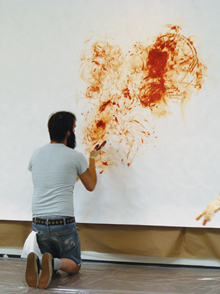 |
   |
| Annie Lapin Parallel Deliria June 6 - July 25, 2008 PARALLEL DELIRIA The work begins with a small group of people, a clique of young art students styled in urban tribal motifs — dreadlocks, tattoos, tattered shorts, bandanas. Hired to assist Annie Lapin in the creation of a diorama-sized new painting for her show Parallel Deliria at Grand Arts, they circle the space of the main gallery slapping their paint-filled hands against the white paper covering the walls. Paddy-cake trails of rusty ochre quickly develop into hills and valleys; next are added broad strokes of golden yellows for sunlight, deep greens for foliage, and various shades of blue for sky and water. Before long figures appear — swimming in the rivers, engaging in conversation or trade or ritual. Just like that, a new world dawns. Perhaps a yearning for spiritual renewal has led Lapin and her merry band to swap out the institutionality of Grand Arts's white-cube architecture for a tableau featuring fresh community sprouting from unspoiled nature. Such an artistic ambition would place this work in a romantic lineage stretching back to Caspar David Friedrich's views atop the Riesen Mountains, looking down upon a heavenly bed of clouds, or Frederic Church taking in a sunset over the Hudson River, or Paul Gauguin lounging in Tahiti. And yet Lapin and her cohorts don't stop with paradise: they keep working tirelessly, and soon their pictured figures and scenes are annihilated by the same tumultuous creativity that brought them into existence. Influxes of new paint pave over the old. Landscape is made into landfill: the painting is literally cut up, rearranged, parts turned on their sides or upside down, much of it crumpled up like trash. Swimmers end up on the floor, wading through dirty shoeprints. Nods to Church and Gauguin are now crowded by suggestions of Kurt Schwitters's Merzbau and Robert Smithson dumping asphalt and mirrors in the desert. A few improvised bits of architectural order — orthogonal lines in paint, tape and string, slats of actual lumber — first push back against, then surrender to, the growing chaos. After a week, the world that so easily came together just as easily flies apart. Eden run through a cubist paper shredder, pureed into postminimalist anti-form. In the end, Lapin's process in making Parallel Deliria becomes the piece's subject matter — more than a retreat to ineffable, redemptive nature, the work is about anxiety and uncertainty, constant turnover and restless improvisation. Right from the start, the choice to paint not directly on the wall but rather on sheets of Tyvek already tilts the piece toward the sketch pad, with its allegiance to process and trail-and-error experimentation (and definitely away from either the pat repetitions of decorative wallpaper or the lasting statements of the mural). Even the monumental size of the resulting paper field is strongly countered by how much the Tyvek comes across as unmonumental, as transient and disposable. But even here Lapin has her recent and telling precedents. The artist herself has cited as inspiration William Somerset Maugham's 1919 The Moon and Sixpence, a novel about a stock-broker-turned-painter (loosely based on Gauguin) who abandons his native England for Tahiti. There he contracts leprosy; the novel ends with him realizing his masterpiece, in a state of growing delirium and blindness, on the walls of his hut, which he orders to be torched upon his death. On one level it's a purely hyperbolic tale about the artist as anti-social genius; but as an account of painting's fraught ambition to negotiate a settlement at the intersection of modern architecture and nature, it foreshadows the actual historical record with eerie fidelity. An impressive list can be assembled of 20th-century architects and designers who started their careers as painters (Lissitzky, Tatlin, Le Corbusier among them), and, vice versa, of painters who influenced or collaborated on architectural projects (Mondrian, Leger, Kandinsky, the Mexican muralists). In the U.S., dialog between leading painters and architects reached a boil beginning in 1949, the year models co-created by Jackson Pollock and the architect Peter Blake went on view at Betty Parsons's gallery, while exhibitions concerning the deployment of avant-garde art within modern interiors were mounted at museums across the country (including MoMA, which installed in toto a new "modern house" designed by Marcel Breuer in its outdoor sculpture garden). Pollock, Robert Motherwell and others continued to work with architects like Breuer and Blake, dreaming up Abstract Expressionist picture windows and moveable walls, but rather than urban structures these ideas most often featured in small family homes destined for upscale suburbs or pastoral vacation communities like the Hamptons. Having succeeded in corralling wild painterly attack and gestural immediacy within the frame of art, these painters now turned their talents to hammering out a peaceful co-existence between the immensity and unpredictability of the great outdoors and the rational laws and geometries of international-style architecture and design. And all this for dwellings that, on the average, each accommodated a maximum of four people. If Lapin's installation at Grand Arts bears resemblance to a backyard barbeque as seen through Pollock-treated glass, it even more strongly suggests the late '50s environments of ex-painter Allan Kaprow, who saw in Pollock's example a way beyond the framed canvas and into real space. Kaprow's trash aesthetic epitomized the manic neo-dada backlash against the earlier international-style vision of how to rationally integrate the various two- and three-dimensional arts. As with Kaprow's chicken-wire and plastic-tarp hovels, or the cardboard debris that Claes Oldenburg used to fill his Kaprow-inspired The Street of 1960, Lapin's painting on Tyvek favors process over product; it sides with the construction site and dumpster over the enduring edifice. But again, Lapin's art differs from that of the neo-dadaists in being more idyllic than urban, more communal than social — more Autumn Rhythm than The Street. Perhaps a basic frame of reference for her art is where the two overlap, where modern progress and wild nature come together in the depopulated, radioactive pastoralism of the toxic waste site (Tyvek, trademark Dupont, is also the material used for hazmat suits). But the vivid sense Lapin conjures of a breakdown in the natural order extends well beyond any direct iconographic references, even beyond more subtle perversions like her color palette, wherein heavy, soil-rich and humid pastels flirt promiscuously with the declaratively bright pinstripe colors of race cars and soda cans. At the core of Lapin's painted universe, coded within its very DNA, is a clash of incompatible pictorial structures. Entering Lapin's room from just past Grand Arts's front doors, the viewer is presented with a hierarchical space, frontal and axial, ceremonial and didactic, much in the manner of church architecture, with focus shepherded down the length of the interior and culminating at the far wall in the rainbow and waterfall motifs that function together very much like a dramatic altarpiece. But as one proceeds into the room, this logic gets overrun by various competitors. There is a countering baroque regime that treats vision as carnal, mobile and performative, a direct correlate of the athletic body indexed in the broad, muscled brushstrokes that dominate so much of the room. This in turn is contradicted by more strictly optical passages, often photographic in their effects, whereby eyesight becomes disembodied, as if installed sovereignly behind a viewfinder, exploring a world passable not by foot but vision only. Soaring prospects open up in which foreground obstructs any imagined physical passage to middle- or background; focal depth skips around randomly; backlighting dissolves some figures into darkly smudged silhouettes, while saccadic restlessness notes others as only a blur. And then, of course, there's the collage aesthetic, with its pieced-together fragments, its randomness, dissonance, contingency, its scattering of perceptions that have no chance of ever adding up to one larger comprehension. (The main hilltop centered altar-like on the backwall is itself a wayward scrap recovered from a demolished landscape originally painted on one of the side walls.) It's hard not to see in all this an expression of a larger set of breakdowns and upheavals, not only on the level of visual technology — as photography and collage give way to cellphone cameras and Photoshop — but beyond. Yes, we know the world is a construction. Not long ago consensus held that this construction was implacable, iron-clad (even church-like) and institutionalized on the scale of all society, one construction for everybody. It was called the spectacle, ideology, the totally administered life, culture industry. Today, however, life is being increasingly privatized, as risk is shifted from society onto individuals through the dismantling of state assistance programs, while much the same goes for our supposedly more DIY culture industry, no longer constructing the world for us but rather encouraging each of us to "do it ourselves." A technology and architecture now rise up around the individual's mobile body, an apparatus of cellphones, laptops, iPods, frequent-flyer rewards. We adapt to constant flux by endlessly crafting habitat makeovers from the sheetrock and duct tape available at Home Depot, by endlessly re-programming our entertainment systems and lifestyles from the bits of content available on cable, the internet, thriftstores. The world is broken down into milling cultural atoms that are archived in increasingly corporate-owned mega-libraries, where they lie as if passively, like natural resources waiting to be mined and operationalized by enterprising consumers. It's an increasingly post-social landscape, and one that still awaits new pictorial strategies that can provide it with an adequate means of representation. In Parallel Deliria, Lapin responds to this emerging paradigm by trying to erect a new set of bearings, even a new system of meaning (a new church?), or perhaps by just rummaging through the vast debris of the old, or doing both at once, without feeling it necessary to distinguish any longer between them — between the fresh and the withered, the organic and the constructed, between relying on faith and relying on your wits. Lane Relyea |

